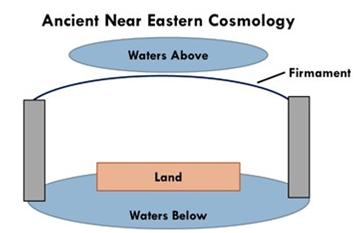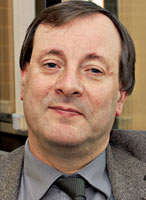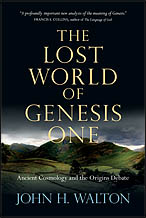In my last blog post we saw that the main message of Genesis 1 is that God is the creator of all. Not only is this a central theme of Genesis 1, but it is also a central theme of the Bible which is reiterated over and over again throughout the Old and New Testaments. In contrast the question of the timing and mechanism of creation events are secondary issues. Nevertheless because of the controversy surrounding these questions we will be talking about them in more detail in the next few blogs. But before we do that there’s one other question we need to address.
When we read Genesis 1 and Genesis 2 we are tempted to view and try to interpret the text using modern, 21st century eyes. But Genesis was written to an ancient, prescientific people, the Hebrews. Before we can understand what Genesis 1 is teaching us today, we must understand what it meant to its original audience. In this context, we must ask the question: Is Genesis 1 meant to convey modern scientific account of creation?
I believe that God did not intend to teach a modern scientific account of creation in Genesis 1. This can be seen from a consideration of Genesis 1:6-8 (English Standard Version).
And God said, “Let there be an expanse in the midst of the waters, and let it separate the waters from the waters.” And God made the expanse and separated the waters that were under the expanse from the waters that were above the expanse. And it was so. And God called the expanse Heaven. And there was evening and there was morning, the second day.

This passage describes the creation by God of an expanse that separates the waters below from the waters above. This raises two questions. First, what is the expanse and second, what are the waters above the expanse?
The word expanse is used 5 times in the passage. The Hebrew word translated as “expanse” is raqiya. A better translation for the word is firmament. The firmament is a solid vault or dome of heaven. Thus in this passage God is describing the creation of a solid dome or vault that separates the waters above the dome from the waters below the dome.
To understand what’s going on here we have to know something about the ancient, near-eastern understanding of cosmology that was shared by the Hebrews, ancient Babylonians and ancient Egyptians. This was based on the common experience of the cosmos by an earth-based observer. If you look at the sky on a clear night what do you see? Well the sky appears to be a solid dome on which the moon and stars move. During the day the sky still looks like a dome and we can see the sun moving across the dome. Sometimes rain comes down from above and so there must be water above the solid dome. At times the dome must be porous to allow for the water above the dome to pass through and produce rain. If you dig in the ground you will eventually hit water, so the ground (land) must be resting on water (the waters below). The dome was believed to be held up by mountains or pillars.
Our first conclusion is that in Genesis 1 God is describing his creation in terms of Ancient Near-Eastern Cosmology rather than in modern scientific terms.
So what are we to make of this? Surely, God must understand what he made and how it works and surely God is not a liar. So what is going on here? I believe that this is an example of accommodation in scripture. John Calvin, the 16th Century Protestant reformer, believed that the Bible is not an astronomical, geographical or biological textbook. Rather when we interpret the Bible we must keep in mind that God “adjusts” his revelation to the capacities of the human mind and heart. Revelation must be scaled down or accommodated to us in order to speak to our limited abilities.

McGrath goes on to say that the accommodation approach “has been by far the most important approach in relation to the interaction of biblical interpretation and the natural sciences.” The accommodation approach has a long tradition of use within Judaism and Christianity.
Perhaps a more familiar example of accommodation is our common experience of the day/night cycle. We know that this cycle is due to the rotation of the earth against a point light source (the sun). Yet, our common experience is that the sun moves across the sky from east to west during the daylight hours. We speak of the sun rising in the east and setting in the west. God also uses this language of common experience in the Bible. There are 52 verses in the Old and New Testaments that refer to the rising and/or setting of the sun.
Our second conclusion is that God in the Genesis 1 account was speaking to his people in terms that they could understand rather than through a modern scientific account which would have been totally incomprehensible to them.
Next in the Christianity and Science series. Two part piece on the timing of creation events:
- Timing of Creation Events – The View from Science
- Timing of Creation Events – The View from the Bible
Questions for further reflection:
- What does it mean to have a literal interpretation of Genesis 1? How might the concept of accommodation affect your view?
- How does the notion of accommodation influence your thinking about the Bible’s description of the timing and mechanism of the creation events in Genesis 1?

Suggestions for further reading:
- Science & Religion: A New Introduction, 2nd Edition, Alister E. McGrath. Wiley-Blackwell, 2010.
- The Lost World of Genesis One: Ancient Cosmology and the Origins Debate, John H. Walton. InterVarsity Press, 2009.
- The Bible and Ancient Science (http://www.ualberta.ca/~dlamoure/asa2013.html), Denis O. Lamoureux. Lectures and lecture notes from a workshop at the 2013 American Scientific Affiliation meeting.
- Added by the editor: PDF with the titles and links to the posts in Tom Ingebritsen‘s Christianity and Science series. Yes, this was created to meet the requests of readers and will be updated. Your interest in and encouragement of this series is much appreciated.
Notes added by the editor
- Alister E. McGrath is professor of theology, ministry, and education and head of the Centre for Theology, Religion, and Culture at King’s College, London [Effective 1 April 2014, he will be returning to the University of Oxford as the Andreas Idreos Professor in Science and Religion (http://www.wycliffehall.org.uk/news/Alister-McGrath)]. He is also involved in theological research and the professional development of clergy from a range of Christian denominations. McGrath has written many books on theology and history, including Luther’s Theology of the Cross and Surprised by Meaning. McGrath is an ordained minister in the Church of England and spends his Sundays pastoring and preaching in a group of rural churches in the beautiful Cotswolds, close to his home in West Oxfordshire. Previously, he served as professor of historical theology and principle of Wycliffe Hall at the University of Oxford. Before becoming a theologian, McGrath conducted research in molecular biophysics at Oxford University and earned a doctorate in biochemistry for his work. McGrath also studied Divinity at Saint John’s College of Cambridge and became ordained as a minister of the Church of England. In 2001, he earned an Oxford Doctorate of Divinity. His extensive experience in the worlds of both science and theology has equipped him to be a powerful voice in the science/faith debate. — From http://biologos.org/blog/author/mcgrath-alister. For McGrath’s material published by InterVarsity Press click here. For two ESN blog reviews of McGrath’s The Passionate Intellect (InterVarsity Press, 2010) click here. ↩
Update: 1/30/2014, 8:22 am. McGrath’s bio.
Tom Ingebritsen is an Associate Professor Emeritus in the Dept. of Genetics, Development and Cell Biology at Iowa State University. Since retiring from Iowa State in 2010 he has served as a Campus Staff Member with InterVarsity Graduate & Faculty Ministry at Iowa State University

I like where you are going. I would be interested in if you comment on Walton’s approach re Function vs material origins in his “Lost World” book. i”d also be interested if you have read Sailhammer where he takes a rather unique view.
I’ll be talking about Walton’s functional vs. material origins view in a later blog. I’ve not had a chance to read Sailhammer’s book yet.
One thing I would certainly agree upon is the problem of reconciling divergent cultural perspectives. I think however that God is a genus! This particular scripture is one on which I have given considerable thought. I would suggest that this scripture, though intended to speak to a people lacking in a modern scientific understanding, was intended to convey eternal knowledge. Though men of the time didn’t know much about the universe beyond what they could see with their eyes God knew everything. Faith and understanding might then lead us to conclude that it is not the scripture that are coming up short but rather our understanding of the universe. Our modern scientific understanding is flawed. This would not be the first time. Evolution is one obvious example. I would suggest to you that contained within those verses are the seed for another more scriptural harmonious understanding of the universe. As it were a new Genesis point. Not an intrinsically religious understanding but rather one based on divine knowledge.
Editorial note to editor’s note: Effective 1 April 2014, Alister McGrath will be returning to the University of Oxford as the Andreas Idreos Professor in Science and Religion: http://www.wycliffehall.org.uk/news/Alister-McGrath
Now Oxford is an even better place to go for those interested in studying science and religion!
Thank-you Dave! What a joy to have members of the Emerging Scholars Network update one-another — and me 🙂 — on the dynamic changes in the academic community. I’ll make changes to the editor’s note.
Please don’t hesitate to send additions, corrections, updates. In February I intend to begin collating Tom Ingebritsen’s posts to create Emerging Scholars Network discussion packets to experiment with on campus beginning in the summer/fall.
If you and/or some of your colleagues may have interest in experimenting with, editing, and/or expanding the material in the coming months, please let me know.
I like how, at the beginning of each post, there is a link to previous articles. It’d be nice if there was a clearly visible link to the next article in the series.
I am enjoying reading this series; thank you!
Thank-you for the reminder Andrew. As editor, I’ve added links to this post and will work on the other posts as time permits. In March I desire to start compiling material for PDF’s to posted on an Emerging Scholars Network (ESN) Resource Page, http://esn.intervarsity.org/resources-and-articles. It is so good to read that you are enjoying the series. Tom Ingebritsen has been an excellent contributor to the ESN blog. To God be the glory!
Note: All of Tom Ingebritsen’s posts can be found by clicking the author link, https://blog.emergingscholars.org/author/tom_ingebritsen/.